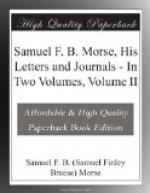“Now the inventor of the registering telegraph did not rise from the perusal of any brilliant paper; he happened to be at leisure on shipboard, ready to contribute and share in the after-dinner conversation of a ship’s cabin, when the occasion arose. Morse’s electro-magnetic telegraph was mainly an invention employing powers and agencies through mechanical devices to produce a given end. It involved the combination of the results of the labors of others with a succession of special contrivances and some discoveries of the inventor himself. There was an ideal whole almost at the outset, but involving great thought, and labor, and patience, and invention to produce an art harmonious in its organization and action.”
After a voyage of over a month Morse reached home and landed at the foot of Rector Street on November 15, 1832. His two brothers, Sidney and Richard, met him on his arrival, and were told at once of his invention. His brother Richard thus described their meeting:—
“Hardly had the usual greetings passed between us three brothers, and while on our way to my house, before he informed us that he had made, during his voyage, an important invention, which had occupied almost all his attention on shipboard—one that would astonish the world and of the success of which he was perfectly sanguine; that this invention was a means of communicating intelligence by electricity, so that a message could be written down in a permanent manner by characters at a distance from the writer. He took from his pocket and showed from his sketch-book, in which he had drawn them, the kind of characters he proposed to use. These characters were dots and spaces representing the ten digits or numerals, and in the book were sketched other parts of his electro-magnetic machinery and apparatus, actually drawn out in his sketch-book.”
The other brother, Sidney, also bore testimony:—
“He was full of the subject of the telegraph during the walk from the ship, and for some days afterwards could scarcely speak about anything else. He expressed himself anxious to make apparatus and try experiments for which he had no materials or facilities on shipboard. In the course of a few days after his arrival he made a kind of cogged or saw-toothed type, the object of which I understood was to regulate the interruptions of the electric current, so as to enable him to make dots, and regulate the length of marks or spaces on the paper upon which the information transmitted by his telegraph was to be recorded.
“He proposed at that time a single circuit of wire, and only a single circuit, and letters, words, and phrases were to be indicated by numerals, and these numerals were to be indicated by dots and other marks and spaces on paper. It seemed to me that, as wire was cheap, it would be better to have twenty-four wires, each wire representing a letter of the alphabet, but my brother always insisted upon the superior advantages of his single circuit.”




